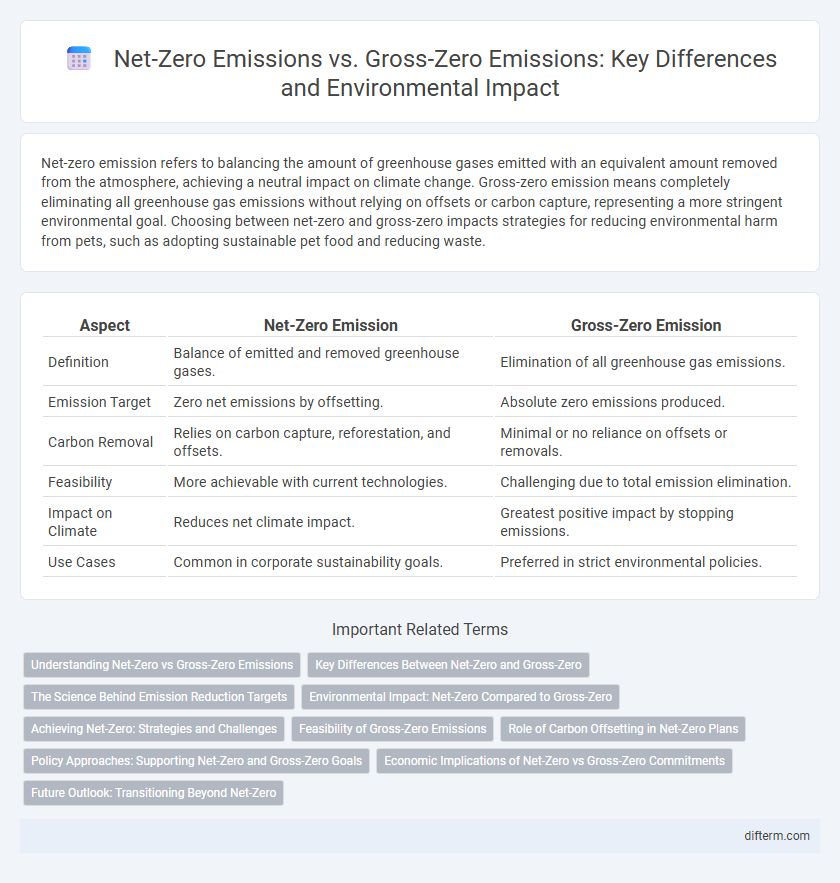Net-zero emission refers to balancing the amount of greenhouse gases emitted with an equivalent amount removed from the atmosphere, achieving a neutral impact on climate change. Gross-zero emission means completely eliminating all greenhouse gas emissions without relying on offsets or carbon capture, representing a more stringent environmental goal. Choosing between net-zero and gross-zero impacts strategies for reducing environmental harm from pets, such as adopting sustainable pet food and reducing waste.
Table of Comparison
| Aspect | Net-Zero Emission | Gross-Zero Emission |
|---|---|---|
| Definition | Balance of emitted and removed greenhouse gases. | Elimination of all greenhouse gas emissions. |
| Emission Target | Zero net emissions by offsetting. | Absolute zero emissions produced. |
| Carbon Removal | Relies on carbon capture, reforestation, and offsets. | Minimal or no reliance on offsets or removals. |
| Feasibility | More achievable with current technologies. | Challenging due to total emission elimination. |
| Impact on Climate | Reduces net climate impact. | Greatest positive impact by stopping emissions. |
| Use Cases | Common in corporate sustainability goals. | Preferred in strict environmental policies. |
Understanding Net-Zero vs Gross-Zero Emissions
Net-zero emissions refer to balancing the amount of greenhouse gases emitted with an equivalent amount removed from the atmosphere, allowing for some residual emissions to remain if they are offset. Gross-zero emissions imply completely eliminating all greenhouse gas emissions without reliance on offsetting measures or carbon removal technologies. Understanding the distinction is crucial for climate policy, as net-zero strategies accommodate practical emission reductions alongside carbon capture, whereas gross-zero demands total cessation of emissions at the source.
Key Differences Between Net-Zero and Gross-Zero
Net-zero emission targets balance emitted greenhouse gases with equivalent carbon removal, allowing some residual emissions offset by carbon capture or reforestation efforts. Gross-zero emission demands the elimination of all greenhouse gas emissions without reliance on offsets, focusing on total cessation of emissions at the source. Key differences highlight net-zero's flexibility versus gross-zero's stricter approach to achieving pure zero emissions in climate action strategies.
The Science Behind Emission Reduction Targets
Net-zero emission targets aim to balance emitted greenhouse gases with equivalent carbon removal, relying on advanced technologies like carbon capture and reforestation to offset residual emissions. Gross-zero emission goals focus on eliminating all emissions at the source, promoting complete reliance on renewable energy and sustainable practices to achieve absolute reductions. Scientific models indicate that net-zero strategies offer flexibility but require rigorous monitoring, while gross-zero approaches demand systemic transformation for long-term climate stabilization.
Environmental Impact: Net-Zero Compared to Gross-Zero
Net-zero emission targets aim to balance emitted greenhouse gases with equivalent removal efforts, often allowing continued emissions offset by carbon capture or reforestation, which can sometimes mask ongoing pollution. Gross-zero emission strives for the complete elimination of emissions at the source, significantly reducing environmental harm by preventing pollutants from entering the atmosphere. Achieving gross-zero emissions typically leads to a more substantial and immediate positive environmental impact than the compensatory approach of net-zero.
Achieving Net-Zero: Strategies and Challenges
Achieving net-zero emissions requires balancing greenhouse gas emissions produced with an equivalent amount removed through carbon capture, reforestation, and renewable energy adoption. Strategies involve enhancing energy efficiency, transitioning to sustainable fuels, and implementing advanced carbon sequestration technologies to address residual emissions. Challenges include the high cost of innovation, technological limitations in scaling carbon removal, and ensuring global cooperation for effective policy enforcement.
Feasibility of Gross-Zero Emissions
Gross-zero emissions require the complete elimination of all greenhouse gas outputs, posing significant technological and economic challenges due to current reliance on fossil fuels and industrial processes. Achieving this goal demands breakthroughs in carbon capture, energy storage, and sustainable infrastructure, alongside unprecedented global coordination and investment. While net-zero allows for some residual emissions balanced by carbon removal, gross-zero mandates total decarbonization, making its feasibility dependent on rapid innovation and transformative policy shifts.
Role of Carbon Offsetting in Net-Zero Plans
Carbon offsetting plays a crucial role in net-zero emission plans by compensating for unavoidable greenhouse gas emissions through activities like reforestation and carbon capture projects. Net-zero targets allow residual emissions to be balanced by verified offsets, enabling organizations to reduce their carbon footprint while supporting sustainable initiatives. Gross-zero emission aims for zero emissions at the source without reliance on offsets, making carbon offsetting a defining feature that differentiates net-zero strategies.
Policy Approaches: Supporting Net-Zero and Gross-Zero Goals
Policy approaches for achieving net-zero emissions emphasize carbon offsetting and flexible reduction targets, allowing residual emissions to be balanced through measures like reforestation and carbon capture. Gross-zero strategies mandate absolute elimination of all greenhouse gas emissions within a defined boundary, often requiring stringent regulations and innovation in clean energy technologies. Governments and regulatory bodies support these goals by implementing tailored frameworks that combine financial incentives, emissions trading schemes, and strict compliance mechanisms to drive both net-zero and gross-zero outcomes.
Economic Implications of Net-Zero vs Gross-Zero Commitments
Net-zero emission commitments often allow for carbon offsetting, enabling industries to balance emissions with removals, which can lower immediate economic burdens and foster innovation in carbon markets. Gross-zero emission targets require absolute elimination of emissions, leading to higher upfront costs due to extensive technology shifts and infrastructure investments but potentially reducing long-term liabilities related to carbon pricing. The economic implications of net-zero versus gross-zero commitments influence policy design, corporate strategies, and investment flows in transition economies.
Future Outlook: Transitioning Beyond Net-Zero
Net-zero emission targets aim to balance emitted greenhouse gases with equivalent carbon removal, while gross-zero emission envisions eliminating all emissions outright. Future outlooks emphasize transitioning beyond net-zero by integrating advanced carbon capture technologies, renewable energy scalability, and systemic policy reforms to achieve gross-zero. This shift promises enhanced climate resilience and aligns with long-term sustainability goals critical for limiting global warming to 1.5degC.
net-zero emission vs gross-zero emission Infographic

 difterm.com
difterm.com